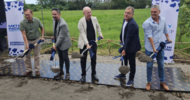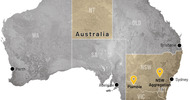
There are fears that the Olmos irrigation project model could be used in future irrigation projects (Photo: Jeremy Horner/Panos)
Peru: Olmos irrigation project sparks development debate
by Zoraida Portillo
The recently launched irrigation and hydropower Olmos megaproject in Peru is hailed a ‘masterpiece of engineering’ aimed at stimulating rural development — but some fear the initiative will mostly benefit big companies.
The project will bring water from the Atlantic side of the Andes to the Pacific side through a tunnel in the mountains, to irrigate the arid Olmos Valley in the country’s northwestern region of Lambayeque and open up 38,500 hectares of land for farming.
Peru’s President Ollanta Humala inaugurated the project, which cost US$580 million, on 18 November — nearly a century after it was first proposed. It is estimated that the project will create 40,000 direct jobs and around 200,000 indirect ones.
The initiative to divert the Huancabamba River that runs into the Atlantic in the mountains of the Piura region was first conceived in 1924 to improve the living conditions of people in Lambayeque, through integrated water, land and crop management. The addition of the hydroelectric component was suggested in the 1940s.
“The main question is how many farmers this project is really going to benefit.”
Jaime Escobedo, Peruvian Centre for Social Studies
The plan is that the water from the Huancabamba River will first be diverted by the Limon Dam into a 20-kilometre long and 4.8-metre wide Trans-Andean tunnel, to the other side of the continental divide.
There, the water joins the Olmos River and is expected to irrigate 5,500 hectares of land. Further down the river, hydroelectric power stations are being built that will generate 4,000 gigawatt-hours of electricity per year.
Then, finally, the water will reach the Palo Verde Dam — which will have a capacity of 790 million cubic metres of water — and will be used to irrigate additional 38,000 hectares of dry land. The idea is to use the land to cultivate crops such as banana, sugar cane, avocado, quinoa and passion fruit.
But although the main aim is to boost food exports, small scale farmers may not be benefit, says Manuel Paulet-Iturri, a specialist in soil and water management, who previously worked at the Inter-American Institute for Cooperation on Agriculture.
“Priority [has been] given to big businesses at the expense of local populations,” he says. “The original plan was different. It had a better control on distribution of water according to demand. But later the government focused on selling the land to finance the work.”













